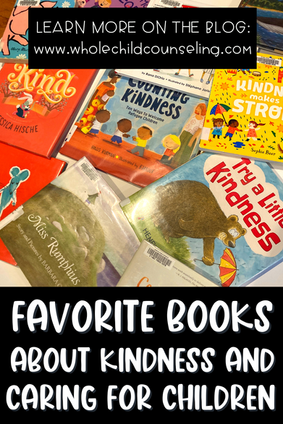top of page
Blog about social emotional learning, school counseling, relaxation coping skills for kids, social skills, and more!
Search


Activities for Teaching Kids How to Interpret and Use Tone of Voice
Explore engaging activities to help children recognize and practice tone of voice including volume, rate, pitch, and intonation. From listening games and emotion matching to tone-based role-play and read-aloud practice, these strategies build listening skills, emotional insight, and social awareness. Ideal for classrooms, counseling groups, or at-home learning.


How to Run a Successful Lunch Bunch Social Skills Group for Elementary Students
A Lunch Bunch is a regular, small-group social skills session held during lunch to support peer connection and social-emotional growth. The post covers how to define goals based on student needs, set small groups (4–10 kids), establish structure and routines, select inclusive activities, include role-model peers, and manage logistics for smooth, empathetic delivery.


7 Thoughts on Processing Life’s Challenges Through Storytelling
These seven reflections explore how storytelling helps children and families process challenges, find meaning, and heal. By sharing personal or fictional stories—through play, metaphors, memory work, and narrative revision—kids can express hard emotions, reframe experiences, and discover growth. Stories become tools to bridge past and future, enrich identity, and foster connection.


5 Ways to Deepen Connection with Your Child
Connection is protective. This post offers five simple ways to strengthen your bond with your child—through listening, shared passions, play, meaningful rituals, and love languages. These tips can help rebuild closeness, improve communication, and support emotional growth at any age.


5 Tips for Teaching Consent and Boundaries to Kids
Turn behavior learning into something kids enjoy. This post walks through four simple steps—Ask Questions, Teach concepts, Practice phrases, and Rally Support—to teach children about consent and boundaries in everyday interactions. They explore comfort levels with touch, how to refuse unwanted affection, role-play asking or saying no, and strategies for adults to back up kids and reinforce their bodily autonomy.


Classroom Benefits of Fidgets and Sensory Tools. How effective are they?
Explore how fidget and sensory tools can help students, especially those with attention or sensory needs, self-regulate, reduce stress, and stay engaged in class. From stress balls, chair bands, and wobble seating to headphones and glitter jars, these tools provide tactile input to support focus and self‑regulation. Guidance includes choosing quiet, non‑distracting options and tailoring tools to individual needs in collaboration with OTs.


9 Ways to Help Kids Improve Their Self-Esteem, Confidence and Self-Worth
Explore nine evidence‑based strategies to help kids build confidence, self-worth, and self-esteem. From recognizing strengths and celebrating effort, to setting achievable goals and encouraging healthy risk‑taking, these tips support growth mindsets and emotional resilience. Learn how consistent encouragement, listening, and empowering choices can help children feel capable, valued, and more secure in themselves.


Free SEL Curriculum, Programs, Training, and Lesson Plans on Social Emotional Learning
This post shares free social emotional learning curriculum, program ideas, training options and lesson plans for educators, counselors and parents. You will find tools like Harmony SEL lesson sets, Choose Love character development units, RULER emotional literacy training, and FRIENDS resilience building programs. These resources support teaching core skills such as emotion recognition, self regulation, empathy, problem solving, and social awareness.


23 Creative Termination Activities for Ending Counseling with Children
End counseling on a positive note with 23 creative activities designed for children. From memory jars and goodbye letters to vision boards and certificate ceremonies, these ideas help young clients reflect on growth, find emotional closure, and feel ready for what’s next—all in ways that are meaningful and child-friendly.


5 Art Therapy-Inspired Activities for Calming Behaviors and Building Resilience by Erica Curtis
Explore five art therapy-inspired activities designed to help children calm big feelings and build emotional resilience. These simple, creative exercises—from scribble maps to strength trees—offer nonverbal ways for kids to express themselves and practice coping skills. No art skill or special supplies needed. Includes tips for guiding reflection and adapting the activities to meet diverse needs for self-regulation and growth.


Activities and Videos to Teach Theory of Mind and Perspective Taking Skills to Children
In this post you'll discover 16 engaging videos and hands‑on activities to support children in building theory of mind and perspective-taking skills. You’ll learn how kids typically develop these abilities around ages 4–5, explore example exercises like joint attention, and get practical ideas—optical illusions, social stories, guessing games—to spark conversation and empathy. Perfect for classrooms, counseling sessions, or at home.


Using Books to Teach Perspective Taking Skills to Children
Using picture books to teach perspective‑taking helps children learn to step into someone else’s shoes. By reading stories with varied characters and viewpoints, you can guide kids to reflect on thoughts, feelings, and motivations. Books can spark discussions and support social‑emotional learning, empathy, and flexible thinking in a supportive, engaging way.


Building Relationships and Trust with Children in Counseling
This post explains why trust and rapport are the foundation for effective work with young clients. It outlines child-centered techniques , like using play, simple language, emotional validation, and consistent boundaries , to create a safe, age-appropriate space where children feel heard, respected, and engaged.


How to Curate a Teacher or School Counselor Capsule Wardrobe
Start by decluttering and identifying the pieces you truly love and wear. Build your capsule with quality staples like tees, midi skirts, tailored trousers, and layering pieces. Mix these with seasonable additions around your personal style. The goal? A simplified, versatile wardrobe that fits your educator or counselor role, and reduces morning outfit stress.


Successful Calm Corner Ideas for Classrooms
A Calm Corner is a dedicated spot in the classroom where kids can self‑regulate and reset. This post offers ideas like soft seating, sensory tools, emotion charts, mindful coloring, and simple visual prompts , along with clear usage guidelines and structure , to help students practice coping in a safe, supportive space.


How to Protect Your Kids Online: Internet Safety & Digital Citizenship
This post offers guidance for protecting children online and promoting digital citizenship. You will find tips on setting privacy controls safe browsing walkthroughs age appropriate online behavior and balanced screen time. Learn how to have open family conversations create media agreements and teach responsible tech habits. Resources and wording ideas support parents educators and counselors in guiding children to use the internet safely.


How to Talk with Kids About Diversity and Inclusion
Children notice differences early , and without guidance, they might learn shame or exclusion instead of curiosity. This post explains why it matters to have honest, age‑appropriate conversations about diversity, equity, and inclusion. It offers practical prompts and reflects on how adults can model inclusive behavior, welcome questions, and promote empathy to help kids build respectful, open‑minded attitudes.


Using Books to Teach Kids About Self-Control: 28 Top Impulse Control Picture Books for Children
This post highlights carefully selected children’s books that illustrate self-control through relatable stories and characters. Each title includes discussion prompts, reflection questions, and hands-on extensions , like creating “pause and think” moments , to help kids internalize self-regulation lessons through literacy.


Activities and Videos to Teach Kids About Self-Control and Impulse Control
This post curates fun, hands-on activities and kid-friendly videos designed to teach self-control and impulse control skills. From freeze-dance and guided movement games to animated stories, songs, and read-alouds, each resource helps kids practice pausing, thinking, and regulating emotions , in school or home settings.


Activities for Teaching Children to Be Kind, Caring, and to Include Others
This post shares simple, hands-on activities that help children practice kindness, empathy, and inclusive behavior. From role-playing scenarios and cooperative games to gratitude circles and “peer buddy” systems, these lessons encourage caring interactions, perspective-taking, and welcoming environments in classrooms or group settings.


Activities and Videos to Teach Kids About Kindness, Caring, and Inclusion
This post shares simple, hands-on activities that help children practice kindness, empathy, and inclusive behavior. From role-playing scenarios and cooperative games to gratitude circles and “peer buddy” systems, these lessons encourage caring interactions, perspective-taking, and welcoming environments in classrooms or group settings.


Using Books to Teach Kids About Kindness
This post recommends carefully chosen picture books that model kindness and empathy in relatable ways. Each title comes with discussion prompts and reflection ideas—like “how would you help?” or “what feelings come up?”—to guide children toward compassionate thinking, caring behavior, and inclusive relationships through story time.


Activities for Teaching Kids Good Sportsmanship, Teamwork, and Cooperation Skills
This post offers practical games, discussion prompts, and lesson ideas to help children learn good sportsmanship, teamwork, and cooperation. Through collaborative activities, reflection questions, and group challenges, kids practice sharing, listening, fair play, and supportive communication in fun, structured ways that reinforce mutual respect and positive team behavior.


Using Books and Videos to Teach Kids Good Sportsmanship, Teamwork, and Cooperation Skills
This post curates engaging books and videos to reinforce sportsmanship, cooperation, and teamwork. Featuring children’s picture books and social story videos, it encourages empathy, fair play, and grit through storytelling, discussion prompts, and shared reflections that help children internalize pro-social values.
bottom of page
